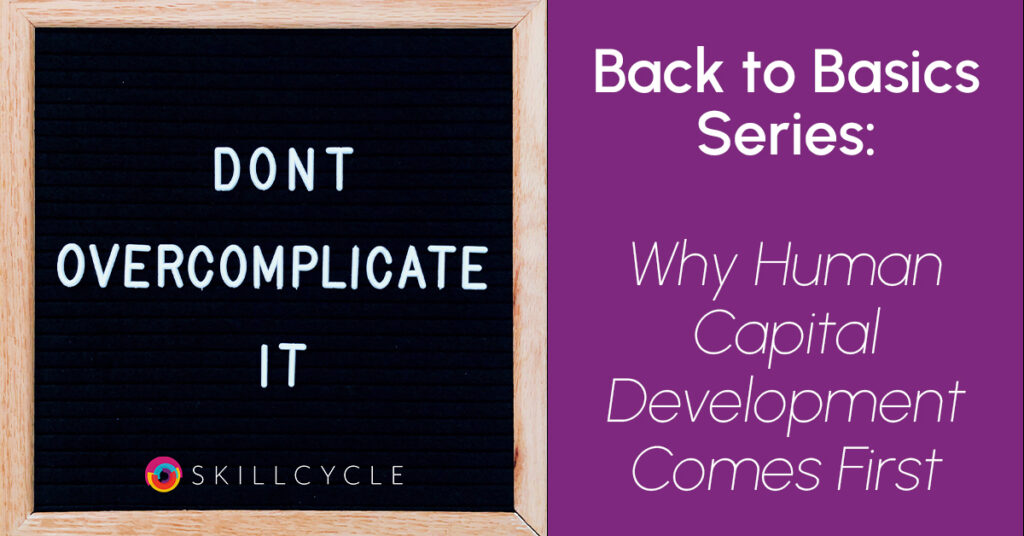
If you aren’t putting your people and their development first in the current job market, you could run into difficulties. Human capital development will be on the radar of every company looking to keep its best talent and stay ahead of competitors.
So, what is human capital development in practice? Put simply, when you define human capital development you are talking about the deliberate, ongoing effort to expand employees’ skills, health, experience, and networks. Once you grasp that definition, the next question is how do you develop human capital at scale and prove that it drives results.
The urgency is clear in the numbers. In 2022 there were 10.9 million job openings but only 6.3 million new hires, according to McKinsey . That’s fuel for the long-running “war for talent.” Employees have options, and one of the top three reasons they walk away is a lack of career development and advancement potential.
That reality highlights a simple equation: companies that invest early in employee growth understand how human capital contributes to development of both people and profits. Effective performance management only works when you first enable performance through targeted learning, coaching, and stretch assignments.
Why? Because you can only manage performance if you are enabling that performance through necessary training and development.
Human capital development refers to how you train, upskill, and support your employees to do well in their current roles and prepare them for future career pathways. It’s an investment in their future and that of the company. Human capital development focuses on the learner, creating provable talent development program that leads to worklife success.
Does prioritizing the development of employees mean every manager needs to be a career coach? Not at all. It’s often more effective for managers to focus on what they do best and leave the development to certified experts. But no matter whose job it is, talent development needs to be a priority so that both people and organizations are prepared for changes that may lie ahead.
And change is coming in many industries. A survey conducted by Gartner revealed insights about how people are feeling about the future of their work, with 80% of the workforce, 92% of managers, and 77% of senior leaders feeling poorly prepared for the future. As well, 40% of respondents said they often handle responsibilities outside of their roles.
HR needs the tools to properly develop employees and ensure they have the skills and expertise they need to do their job well. Only then can you assess and manage their performance for future improvement.
Get these steps in the correct order, and you’ll start to make tangible changes in how your organization promotes career agility and closes skills gaps.
In the current job market, few companies can afford to ignore the need to develop their workforce. According to Gartner, 58% of the workforce needs new skills to get their jobs done. Not to move up within the organization and not to prepare for a future role, but to simply handle the responsibilities of their current positions.
Developing employees so they can be more effective and productive in their roles will benefit both people and organizations. However, moving directly to managing how someone performs in a role without first developing their capacity to succeed is skipping a critical step.
Only when you connect your employees’ goals to those of your company can you see real progress in worklife success.
Your people want to grow. If you offer them the development they need to be successful, you can boost their happiness at work and help them envision a future within the organization.
Putting human capital development before performance management creates a positive impact throughout the company. We already know that employees who feel engaged, valued, and cared about are more likely to stay with their employers instead of leaving for other opportunities.
Let’s explore some other benefits that ripple through individuals, HR teams, and organizations when these steps happen correctly.


HR practitioners have been navigating layers of complexity in a labor market that has launched trends like The Great Resignation, “quiet quitting,” and The Great Reshuffle into mainstream conversations. Constantly trying to do more with less, HR practitioners need more effective ways to help develop employees and fill growing skills gaps in organizations.
When these challenges are proactively addressed, employees become more engaged in learning and their jobs, making performance easier to manage.

Your workforce is a huge driver of business growth—or a detraction from it. Research from PwC shows that the workforce is the number one risk to company growth. The good news is that the flip side is also true. Harnessing the power of your people can exponentially drive growth forward.
Companies who get the development equation right will see better engagement and retention and likely a better return on their learning investments.
Everyone benefits when companies use a proactive approach to engage, develop, and retain their employees. SkillCycle supports every stage of the employee lifecycle with learning at its core, so leaders, teams, and companies can focus on growth.
SkillCycle is a worklife success suite built from the belief that we can do better. Learn how our Human Capital Development Suite helps you rethink people success across the entire employee lifecycle.
If you have ever wondered what is human capital development or asked “how do you develop human capital in practice?” the roadmap starts here.
Think of a skills audit as the organization’s GPS. By comparing the capabilities you have with those you need, HR turns vague ideas about human capital and development into data-driven action.
Once gaps are visible, turn them into SMART goals that employees co-own with their managers. Clear targets show every team member how to develop human capital in a way that supports the wider business plan.
At least 83 % of companies now centralize training in an LMS. A single platform delivers micro-learning, certifications, and AI-powered content suggestions exactly when people need them.
Gallup research shows 80 % of employees who receive meaningful feedback each week are fully engaged. Frequent check-ins keep new skills sticky and maintain momentum across all pillars of human capital development.
Goals gain traction when they show up in the numbers leaders already track—sales velocity, customer NPS, or quality scores. Adding skill-lift metrics to those dashboards makes human capital development as visible as revenue growth.
To define human capital development in practice, most analysts group it into four pillars. Remove one, and performance wobbles:
Managers drive roughly 70 % of the variance in team engagement. When leaders coach, model continuous learning, and budget for training, employees quickly see how human capital contributes to development at both personal and company levels.
Practical steps leaders can take:
Employees often ask, “How does human capital contribute to development?” The answer is simple: healthy, skilled, and connected people innovate faster, stay longer, and grow revenue sooner. Start with a skills audit, translate gaps into shared goals, deliver learning through an LMS, and back everything with feedback tied to KPIs. When leadership champions the process, SkillCycle’s Human Capital Development Suite turns that blueprint into daily practice and lifts performance across every metric that matters.
The four types of human capital development are education and skills, health and well-being, experience and tacit knowledge, and social capital.
Examples include job-specific certifications (education), ergonomic workstations (health), mentorship programs (experience), and cross-functional collaboration tools (social capital).
To develop human capital, conduct a skills audit, set SMART learning goals, deliver training through an LMS, maintain continuous feedback, and tie progress to business KPIs.
Human capital drives development by boosting productivity, sparking innovation, and improving retention—outcomes that lift revenue and market growth.
Human capital development is continuous, data-informed, aligned to organizational goals, and centered on people, balancing immediate skill needs with long-term career growth.